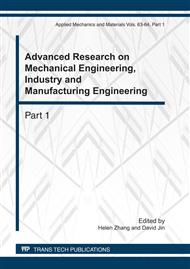[1]
Dickson G.W. Analysis of vendor selection system and decision. Journal of Purchasing, no. 2, (1966), pp.5-17.
Google Scholar
[2]
Weber C A, Current J R, Benton W C. Vendor selection criteria and methods. European Journal Operational Research, no. 50, (1991), pp.2-18.
DOI: 10.1016/0377-2217(91)90033-r
Google Scholar
[3]
Current J R, Weber C A. Application of facility location modeling constructs to vendor selection problem. European Journal Operational Research, no. 76, (1994), pp.387-396.
DOI: 10.1016/0377-2217(94)90275-5
Google Scholar
[4]
Tagaras G and Lee H L. Economic models for vendor evaluation with quality cost analysis. Management Science, Vol. 42, no. 11, (2006), pp.1531-1543.
DOI: 10.1287/mnsc.42.11.1531
Google Scholar
[5]
Gong Yong, Yao Li, Sha Ji-chang, Wang Chang-ying. Study on collaboration supply based on minimal inventory cost. Computer Integrated Manufacturing Systems, Vol. 10, no. 3, (2004), pp.322-325.
Google Scholar
[6]
Liu Chun-lin, He Jian-min, Shi Jian-jun. Study on collaboration-supply in supply chain. Journal of Management Science in China, Vol. 5, no. 2, (2002), pp.29-33.
Google Scholar
[7]
Liu Cheng, Chen Zhi-ya. Research of vendors selection problem with time restriction and allowing shortage. Nature Science Journal of Xiangtan University, Vol. 31, no. 2, (2009), pp.160-165.
Google Scholar
[8]
D. Dubois, H. Prade. Systems of linear fuzzy constraints. Fuzzy Sets and Systems, Vol. 3, no. 1, (1980), pp.37-48.
DOI: 10.1016/0165-0114(80)90004-4
Google Scholar
[9]
D. Dubois, H. Prade. The mean value of a fuzzy number . Fuzzy Sets and Systems, Vol. 24, no. 3, (1987) pp.279-300.
DOI: 10.1016/0165-0114(87)90028-5
Google Scholar
[10]
Enriqueta Vercher, Jose D. Bermudez, Jose Vicent Segura. Fuzzy Portfolio Optimization under downside risk measures. Fuzzy Sets and Systems, Vol. 158, no. 7, (2007), pp.769-782.
DOI: 10.1016/j.fss.2006.10.026
Google Scholar
[11]
Li Dengfeng, Fuzzy Multi-Objective Many-Person Decision Makings and Games, Beijing: National Defense Industry Press, (2003).
Google Scholar
[12]
M.G. Speranza. Linear Programming model for Portfolio optimization. Finance, no. 14, (1993), pp.107-123.
Google Scholar


